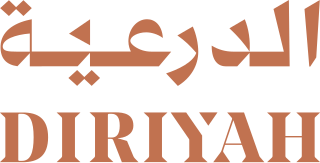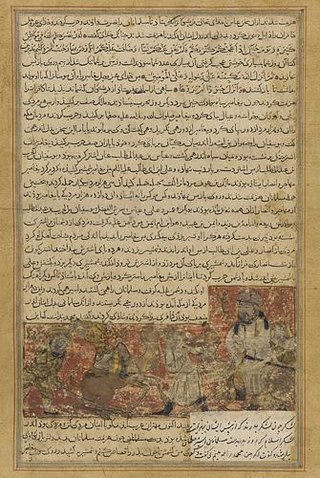
Diriyah, formerly romanized as Dereyeh and Dariyya, is a town and governorate in Saudi Arabia located on the northwestern outskirts of the Saudi capital, Riyadh. Diriyah was the original home of the Saudi royal family, and served as the capital of the Emirate of Diriyah under the first Saudi dynasty from 1727 to 1818. Today, the town is the seat of the Diriyah Governorate—which also includes the villages of Uyayna, Jubayla, and Al-Ammariyyah, among others—and is part of Ar Riyad Province.

The Battle of the Trench, also known as the Battle of Khandaq and the Battle of the Confederates, was part of the conflict between the Muslims and the Quraysh, where this time the Quraysh took the offensive and advanced on the Muslims, who defended themselves in Medina by digging a trench around their settlement at the suggestion of Salman the Persian. The battle, which took place in 627 and lasted around two weeks, was lightly fought, with the Muslims reported to have suffered five to six casualties and the Quraysh three.
Amr ibn Hisham (Arabic: عَمْرو بن هِشَام, romanized: ʿAmr ibn Hishām; also known as Abū Jahl by Muslims c. was the Meccan Qurayshi polytheist leader of the Mushrikites known for his opposition to the Islamic prophet Muhammad. He was the most prominent flag-bearer of opposition towards Islam.
Jābir ibn ʿAbd Allāh ibn ʿAmr ibn Ḥarām al-Anṣārī, Abu Muhammad and Abu Abd al-Rahman also wrote his nickname was a prominent companion of the Islamic prophet Muhammad. Imami sources say Jabir was one of Ali's special and chosen companions and one of Hassan, Hussein, Zain al-Abidin and Muhammad Baqir's companions. Jaber narrated hadiths from Abu Bakr, Umar, Ammar ibn Yasir and Muadh ibn Jabal, and he narrated hadiths from young companions including Saʽid al-Khudri and Abu Hurayra. Jabir bin Abdullah also had a scientific reputation among the companions. According to Hisham ibn Urwah, he had a circle for teaching in the Prophet's Mosque, which brought followers around him in connection with the Quran.

The Battle of Uhud was fought between the early Muslims and the Mushrikites during the Muslim–Mushrikite wars in a valley north of Mount Uhud near Medina on Saturday, 23 March 625 AD.

The Battle of Hunayn was a conflict between the Muslims of the Islamic prophet Muhammad and the tribe of Qays in the aftermath of the conquest of Mecca. The battle took place in 8 AH in the Hunayn valley on the route from Mecca to Taif. The battle ultimately ended in a decisive victory for the Muslims, and it is one of the few battles mentioned by name in the Qur'an, where it appears in Surat at-Tawbah.

Abu Ayyub al-Ansari — born Khalid ibn Zayd ibn Kulayb ibn Tha'laba in Yathrib — was from the tribe of Banu Najjar, was a close companion and the standard-bearer of the Islamic prophet Muhammad. Abu Ayyub was one of the Ansar of the early Islamic history, those who supported Muhammad after the hijra (migration) to Medina in 622. The patronym Abu Ayyub, means father (abu) of Ayyub. Abu Ayyub died of illness during the First Arab Siege of Constantinople.
The Banū Aws or simply Aws was one of the main Arab tribes of Medina. The other was Khazraj, and the two, constituted the Ansar after the Hijra.
The Ansar or Ansari are the local inhabitants of Medina who took the Islamic prophet Muhammad and his followers into their homes when they emigrated from Mecca during the hijra. They belonged to the tribes of Banu Khazraj and Banu Aus.

The Relics of Muhammad are a series of objects venerated in Islam that are associated with Muhammad.
The Expedition of Qatan, was the first Raid on the Banu Asad bin Khuzaymah tribe, which occurred directly after the Battle of Hamra al-Asad in the year 4 A.H of the Islamic calendar.
The Raid on Nakhla was a raid that was initially unplanned by the companions of Muhammad, but is considered to be the first successful raid against the Meccans, since it was carried out during an espionage event, this raid took place at Nakhla, in the Hejazi region of what is now Saudi Arabia. It took place in Rajab A.H. 2. The commander was 'Abdullah ibn Jahsh al-Asadi, whom Muhammad dispatched to Nakhla as the head of 12 Emigrants with six camels.
The raid on Amarr, also known as the Raid on Ghatafan, occurred directly after the Invasion of Sawiq in the year A.H. 3 of the Islamic calendar, March 624. The expedition was ordered by Muhammad after he received intelligence that the Banu Muharib and Banu Thalabah tribes were planning to raid the outskirts of Madinah. Therefore, Muhammad launched a pre-emptive strike with 450 men.
The Expedition of al Raji, occurred directly after the Battle of Uhud in the year AH 4 of the Islamic calendar.
The Expedition of al-Muraysiʿ was an early Muslim campaign against the tribe of Banu Mustaliq which took place in December 627 CE.
The expedition of Dhat al-Riqa took place in July AD 625, or after the Battle of Khaybar in AD 628, i.e. AH 7 of the Islamic calendar. Two Quran verses, 5:11 and 4:101, are related to this event.
The demolition or burning of Masjid al-Dirar , or the Mosque of Dissent, is mentioned in the Qur'an. Masjid al-Dirar was a Medinian mosque that was erected close to the Quba Mosque and which the Islamic prophet Muhammad initially approved of but subsequently had destroyed while he was returning from the Expedition to Tabouk. In the main account narrated by the majority of scholars, the mosque was built by 12 hypocrites (munafiqeen) on the commands of Abu 'Amir al-Rahib; a Hanif who refused Muhammad's invitation to Islam and instead fought along with the Meccan non-Muslims against Islam in the Battle of Uhud. Abu 'Amir reportedly urged his men to establish a stronghold and prepare whatever they can of power and weapons as he promised and insinuated to them that he will lead an army, backed by Heraclius, to fight Muhammad and his companions, and defeat his message by expelling him from Medina. Ahmad ibn Yahya al-Baladhuri also relates that the men, who built the Al-Dirar mosque "for mischief and for infidelity and to disunite the Believers" refused to pray in Quba Mosque claiming that it was built in a place where a donkey used to be tied up.

Sahifah of al-Ridha, also known as Sahifat of al-Reza and Sahifatal-Imam al-Ridha, is a collection of 240 hadiths attributed to Ali ibn Musa al-Ridha, the eighth Shia Imam.
People of the Ditch is a story mentioned in Surah Al-Burooj of the Qur'an. It is about people who were thrown into a ditch and set afire, due to their belief in Allah.
Arab archery is the traditional style of archery practiced by the Arab peoples of the West Asia and North Africa from ancient to modern times.






